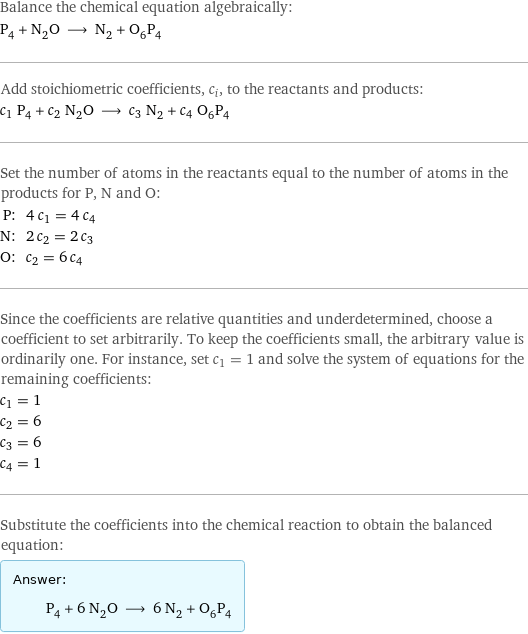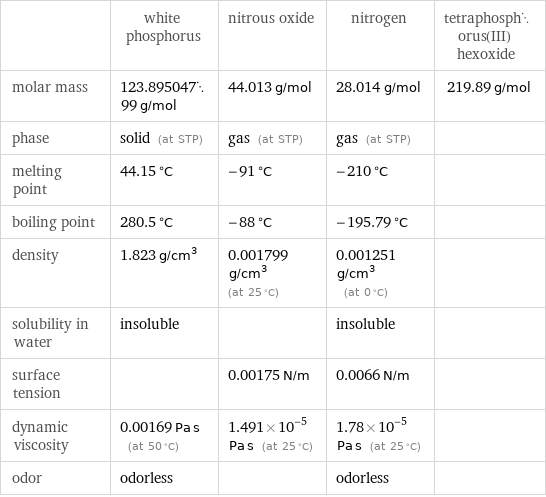Input interpretation

P_4 white phosphorus + N_2O nitrous oxide ⟶ N_2 nitrogen + O_6P_4 tetraphosphorus(III) hexoxide
Balanced equation

Balance the chemical equation algebraically: P_4 + N_2O ⟶ N_2 + O_6P_4 Add stoichiometric coefficients, c_i, to the reactants and products: c_1 P_4 + c_2 N_2O ⟶ c_3 N_2 + c_4 O_6P_4 Set the number of atoms in the reactants equal to the number of atoms in the products for P, N and O: P: | 4 c_1 = 4 c_4 N: | 2 c_2 = 2 c_3 O: | c_2 = 6 c_4 Since the coefficients are relative quantities and underdetermined, choose a coefficient to set arbitrarily. To keep the coefficients small, the arbitrary value is ordinarily one. For instance, set c_1 = 1 and solve the system of equations for the remaining coefficients: c_1 = 1 c_2 = 6 c_3 = 6 c_4 = 1 Substitute the coefficients into the chemical reaction to obtain the balanced equation: Answer: | | P_4 + 6 N_2O ⟶ 6 N_2 + O_6P_4
Structures

+ ⟶ +
Names

white phosphorus + nitrous oxide ⟶ nitrogen + tetraphosphorus(III) hexoxide
Equilibrium constant
![Construct the equilibrium constant, K, expression for: P_4 + N_2O ⟶ N_2 + O_6P_4 Plan: • Balance the chemical equation. • Determine the stoichiometric numbers. • Assemble the activity expression for each chemical species. • Use the activity expressions to build the equilibrium constant expression. Write the balanced chemical equation: P_4 + 6 N_2O ⟶ 6 N_2 + O_6P_4 Assign stoichiometric numbers, ν_i, using the stoichiometric coefficients, c_i, from the balanced chemical equation in the following manner: ν_i = -c_i for reactants and ν_i = c_i for products: chemical species | c_i | ν_i P_4 | 1 | -1 N_2O | 6 | -6 N_2 | 6 | 6 O_6P_4 | 1 | 1 Assemble the activity expressions accounting for the state of matter and ν_i: chemical species | c_i | ν_i | activity expression P_4 | 1 | -1 | ([P4])^(-1) N_2O | 6 | -6 | ([N2O])^(-6) N_2 | 6 | 6 | ([N2])^6 O_6P_4 | 1 | 1 | [O6P4] The equilibrium constant symbol in the concentration basis is: K_c Mulitply the activity expressions to arrive at the K_c expression: Answer: | | K_c = ([P4])^(-1) ([N2O])^(-6) ([N2])^6 [O6P4] = (([N2])^6 [O6P4])/([P4] ([N2O])^6)](../image_source/d792c33f8b2f45b9ea7c55a3d45ed1f5.png)
Construct the equilibrium constant, K, expression for: P_4 + N_2O ⟶ N_2 + O_6P_4 Plan: • Balance the chemical equation. • Determine the stoichiometric numbers. • Assemble the activity expression for each chemical species. • Use the activity expressions to build the equilibrium constant expression. Write the balanced chemical equation: P_4 + 6 N_2O ⟶ 6 N_2 + O_6P_4 Assign stoichiometric numbers, ν_i, using the stoichiometric coefficients, c_i, from the balanced chemical equation in the following manner: ν_i = -c_i for reactants and ν_i = c_i for products: chemical species | c_i | ν_i P_4 | 1 | -1 N_2O | 6 | -6 N_2 | 6 | 6 O_6P_4 | 1 | 1 Assemble the activity expressions accounting for the state of matter and ν_i: chemical species | c_i | ν_i | activity expression P_4 | 1 | -1 | ([P4])^(-1) N_2O | 6 | -6 | ([N2O])^(-6) N_2 | 6 | 6 | ([N2])^6 O_6P_4 | 1 | 1 | [O6P4] The equilibrium constant symbol in the concentration basis is: K_c Mulitply the activity expressions to arrive at the K_c expression: Answer: | | K_c = ([P4])^(-1) ([N2O])^(-6) ([N2])^6 [O6P4] = (([N2])^6 [O6P4])/([P4] ([N2O])^6)
Rate of reaction
![Construct the rate of reaction expression for: P_4 + N_2O ⟶ N_2 + O_6P_4 Plan: • Balance the chemical equation. • Determine the stoichiometric numbers. • Assemble the rate term for each chemical species. • Write the rate of reaction expression. Write the balanced chemical equation: P_4 + 6 N_2O ⟶ 6 N_2 + O_6P_4 Assign stoichiometric numbers, ν_i, using the stoichiometric coefficients, c_i, from the balanced chemical equation in the following manner: ν_i = -c_i for reactants and ν_i = c_i for products: chemical species | c_i | ν_i P_4 | 1 | -1 N_2O | 6 | -6 N_2 | 6 | 6 O_6P_4 | 1 | 1 The rate term for each chemical species, B_i, is 1/ν_i(Δ[B_i])/(Δt) where [B_i] is the amount concentration and t is time: chemical species | c_i | ν_i | rate term P_4 | 1 | -1 | -(Δ[P4])/(Δt) N_2O | 6 | -6 | -1/6 (Δ[N2O])/(Δt) N_2 | 6 | 6 | 1/6 (Δ[N2])/(Δt) O_6P_4 | 1 | 1 | (Δ[O6P4])/(Δt) (for infinitesimal rate of change, replace Δ with d) Set the rate terms equal to each other to arrive at the rate expression: Answer: | | rate = -(Δ[P4])/(Δt) = -1/6 (Δ[N2O])/(Δt) = 1/6 (Δ[N2])/(Δt) = (Δ[O6P4])/(Δt) (assuming constant volume and no accumulation of intermediates or side products)](../image_source/f8a338f56b899e67ddae9d552837e66f.png)
Construct the rate of reaction expression for: P_4 + N_2O ⟶ N_2 + O_6P_4 Plan: • Balance the chemical equation. • Determine the stoichiometric numbers. • Assemble the rate term for each chemical species. • Write the rate of reaction expression. Write the balanced chemical equation: P_4 + 6 N_2O ⟶ 6 N_2 + O_6P_4 Assign stoichiometric numbers, ν_i, using the stoichiometric coefficients, c_i, from the balanced chemical equation in the following manner: ν_i = -c_i for reactants and ν_i = c_i for products: chemical species | c_i | ν_i P_4 | 1 | -1 N_2O | 6 | -6 N_2 | 6 | 6 O_6P_4 | 1 | 1 The rate term for each chemical species, B_i, is 1/ν_i(Δ[B_i])/(Δt) where [B_i] is the amount concentration and t is time: chemical species | c_i | ν_i | rate term P_4 | 1 | -1 | -(Δ[P4])/(Δt) N_2O | 6 | -6 | -1/6 (Δ[N2O])/(Δt) N_2 | 6 | 6 | 1/6 (Δ[N2])/(Δt) O_6P_4 | 1 | 1 | (Δ[O6P4])/(Δt) (for infinitesimal rate of change, replace Δ with d) Set the rate terms equal to each other to arrive at the rate expression: Answer: | | rate = -(Δ[P4])/(Δt) = -1/6 (Δ[N2O])/(Δt) = 1/6 (Δ[N2])/(Δt) = (Δ[O6P4])/(Δt) (assuming constant volume and no accumulation of intermediates or side products)
Chemical names and formulas

| white phosphorus | nitrous oxide | nitrogen | tetraphosphorus(III) hexoxide formula | P_4 | N_2O | N_2 | O_6P_4 name | white phosphorus | nitrous oxide | nitrogen | tetraphosphorus(III) hexoxide IUPAC name | tetraphosphorus | nitrous oxide | molecular nitrogen |
Substance properties

| white phosphorus | nitrous oxide | nitrogen | tetraphosphorus(III) hexoxide molar mass | 123.89504799 g/mol | 44.013 g/mol | 28.014 g/mol | 219.89 g/mol phase | solid (at STP) | gas (at STP) | gas (at STP) | melting point | 44.15 °C | -91 °C | -210 °C | boiling point | 280.5 °C | -88 °C | -195.79 °C | density | 1.823 g/cm^3 | 0.001799 g/cm^3 (at 25 °C) | 0.001251 g/cm^3 (at 0 °C) | solubility in water | insoluble | | insoluble | surface tension | | 0.00175 N/m | 0.0066 N/m | dynamic viscosity | 0.00169 Pa s (at 50 °C) | 1.491×10^-5 Pa s (at 25 °C) | 1.78×10^-5 Pa s (at 25 °C) | odor | odorless | | odorless |
Units
